Abstract
Introduction: Audio podcasts are an e-learning format that may help to motivate students to deal with the contents of medical education more intensely. We adopted a well-proven format from radio broadcasting, the radio documentary, to direct the listeners’ attention to information about practical courses in biochemistry over a period of 20 minutes at most. Information, original sounds, and a specific atmosphere allow listeners to perceive the contents intensely.
Method: In order to organise the production of the podcast as cost-efficient and least time-consuming as possible, a student, a teacher, a clinician, and a technical assistant compile the core themes of their respective text blocks in an editorial conference first. After that, the speakers can elaborate on and record their blocks independently. Coordination is widely handled by the student. At two points of time, the podcasts were evaluated by the medical students by means of a questionnaire.
Results: With little cost and time expenses, eight podcasts were produced. They have been used by the students extensively and have also been evaluated very positively by non-student listeners. For long-term usage, a regular reference to the podcast offer is required in the courses.
Conclusion: Involving students, successful podcasts can be produced to support classroom teaching with little expenses and contribute to the external presentation of the medical faculty.
Keywords: podcast, radio feature, radio documentary, practical course biochemistry, elearning
Zusammenfassung
Einleitung: Audiopodcasts sind ein e-Learning Format, mit dem Studierende motiviert werden können, sich intensiver mit Lerninhalten des Medizinstudiums zu beschäftigen. Wir haben ein bewährtes Format aus dem Hörfunk, den „gebauten Beitrag“, übernommen, um die Aufmerksamkeit der Zuhörer über Zeiträume bis zu 20 Minuten auf Informationen zum Biochemiepraktikum zu richten. Informationen, O-Ton (Original-Ton) und spezifische Atmosphäre lassen den Hörer die Inhalte intensiv erleben.
Methode: Um die Erstellung der Podcasts möglichst kostengünstig und wenig zeitintensiv zu gestalten, erarbeiten zunächst je ein Studierender, Dozent, Kliniker und technischer Angestellter in einer Redaktionskonferenz die Themenschwerpunkte der ihnen zugeordneten Textblöcke. Anschließend können die Sprecher die Blöcke unabhängig voneinander ausarbeiten und einsprechen. Die Koordination wird dabei weitgehend von dem Studierenden übernommen. Mit einem Fragebogen wurden die Podcasts zu zwei Zeitpunkten von Medizinstudierenden evaluiert.
Ergebnisse: Mit geringem zeitlichen und finanziellen Aufwand wurden 8 Podcasts erstellt und unter http://www.podcampus.de veröffentlicht. Sie wurden in großem Umfang von den Studierenden genutzt und auch von vielen nicht studentischen Hörern sehr positiv bewertet. Für eine langfristige Nutzung ist ein regelmäßiger Hinweis auf das Podcast Angebot in Lehrveranstaltungen notwendig.
Schlussfolgerung: Erfolgreiche Podcasts zur Unterstützung der Präsenzlehre können mit geringem Aufwand unter Einbezug von Studierenden erstellt werden und tragen zur Außendarstellung der Medizinischen Fakultät bei.
Introdcution
For quite some time, especially the practical courses in biochemistry were deemed to be difficult amongst Hamburg medical students [1]. Biochemistry is a very abstract subject many medical students have difficulties with. In order to increase the students’ interest and therewith the motivation for self-organised learning, we expanded the e-learning offer for biochemical courses at the University Medical Center Hamburg-Eppendorf (UKE) in 2007 to include audio podcasts. For this, we relied on the most used journalistic format from radio broadcasting, the radio documentary (see Figure 1 (Fig. 1)). What is characteristic of the radio documentary is the interplay between host and original sounds. The focus is on the text of the host, running through the feature like a red thread. Original sounds are to concretise and deepen the experience by accentuating statements and personalities. Because of their authenticity, they are particularly credible and elaborate on what the host only touched upon. Thanks to the new voice and often times a new acoustic environment, the feature becomes more lively and invites to continue listening [2], [3].
Figure 1. Modular structure of the podcasts on practical courses in biochemistry. The text of the host is interrupted by original sounds and atmos (atmospheric recordings taken during the course).

Many e-learning projects are initialised with the help of generous funding subsidies and can often not be continued once the funding is terminated [4]. We are here presenting a cost-efficient project along with means of how to continue it with a long-term perspective. At the same time we are trying to answer the question whether audio podcasts in the shape of radio documentaries have some kind of expiry date. Is the quality of the features still recognized in the same way after a longer useful time?
Setting up audio podcasts for practical courses in biochemistry
Usually, students use scripts and textbooks to prepare for conducting and interpreting experiments in practical courses. The UKE podcasts are intended to provide them with another interesting insight into the topic of the practical course and, in addition, strengthen their intrinsic motivation for learning. Different groups of people are responsible for conducting the course, and they are all included with original sounds in the podcasts (see Figure 2 (Fig. 2)). The teacher explains the theoretical background, a technical assistant helps with the practical implementation. Another group, not an integral part of the course but just as important as the others, are the clinicians, who illustrate the relevance of the conducted experiments with regards to patient care. The part of the host, which is central to the feature, is taken over by a student, who receives a € 100 expense allowance per podcast at the UKE.
Figure 2. Respective roles of the groups of people contributing to the course.
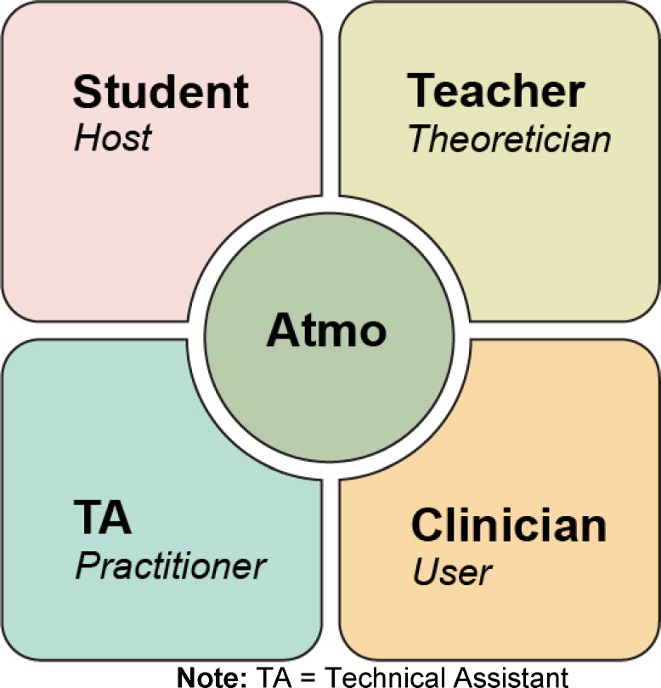
Producing the podcasts, we paid attention to keeping the time burden as low as possible for all involved. At first, a student, a teacher, a technical assistant, and a clinician meet for an editorial conference in order to compile the themes of the text blocks assigned to the different speakers (see Figure 3 (Fig. 3)). Each speaker role comprises two to three text blocks per feature, two to four minutes each. Following the editorial conference, the text blocks are elaborated on independently on the basis of the guiding keywords assigned. They are subsequently put together electronically as a feature manuscript by the host. The manuscript is double-checked by the teacher and then approved for recording which can be done independently at any time by the speakers. A conventional office desktop PC, the audio software Audacity (freeware), and a USB microphone (around € 50) are sufficient means for recording. Finally, the host compiles the recorded text blocks to represent the completed feature using the software Audacity. The audio podcasts were published on the e-learning platform “Mephisto” hosted by the UKE as well as in the cross-university podcast platform “Podcampus” of Hamburg University (http://www.podcampus.de/channels/61).
Figure 3. Production scheme for the podcasts on practical courses.
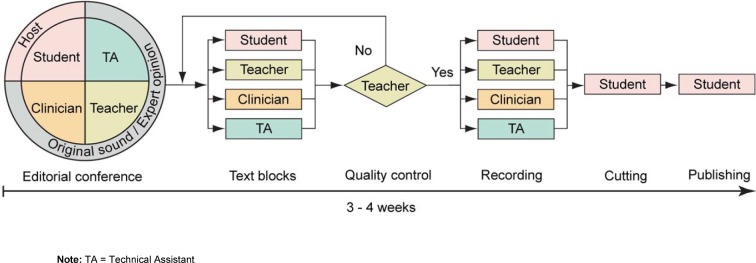
Method
Between 2007 and 2010, eight podcasts have been framed for practical courses in biochemistry (see Table 1 (Tab. 1)). To address the question whether over time there is a change in quality to be noticed with regards to audio podcasts in the shape radio documentaries, we have employed a self-developed questionnaire on paper. The quality of the audio podcast is evaluated in a descending range from one to six with regards to listening experience, structure (i.e. the distribution of speaker roles), topicality, feature length, and overall satisfaction. Apart from their gender, probands indicated whether they listened to the podcast during the corresponding course. Proposals and criticism as well as general recommendations concerning the use of podcasts could be noted down in a free-text field. The questionnaire introduced in 2012 contained additional questions concerning usage and benefits of audio podcasts (see Tables 2 (Tab. 2) and 3 (Tab. 3)).
Table 1. Access numbers of the produced podcasts on Podcampus (as of May 21st, 2013).
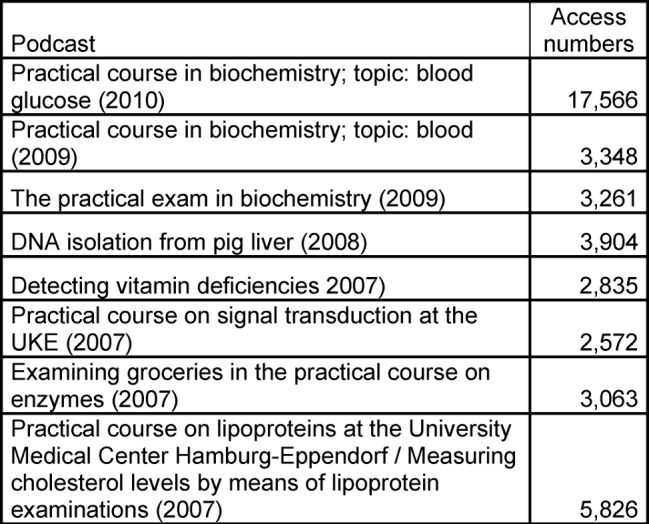
Table 2. Characteristics from the evaluation of the questionnaire.
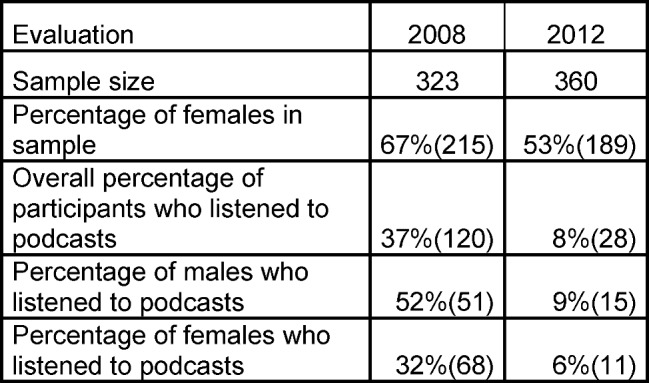
Table 3. What was the podcast used for? (survey 2012).
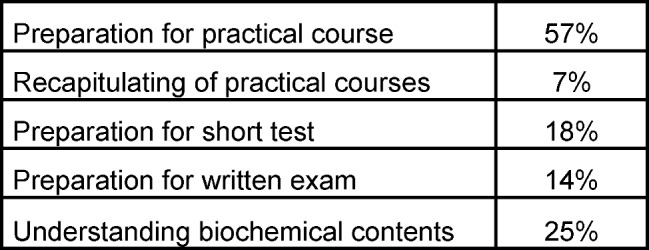
In 2008 and 2012, the questionnaire was distributed amongst third semester students in practical courses in biochemistry at the UKE. The independent samples t-Test [5] is used as a method of inference statistics to test for differences in podcast quality (α=0.05) between 2008 and 2012. The statistical analysis was conducted using the statistics software IBM SPSS Statistics 20.0.0.
Results
The individual podcasts have been extensively used by both students of the UKE and the interested public. Their traffic rates on Podcampus (see Table 1 (Tab. 1)) exceed by far the number of medical students in Hamburg (close to 400 per year). Unfortunately, it is impossible to distinguish between accesses from students and from other users. Thus, from these figures we cannot draw any conclusions on our primary target group. We have no explanation for the extremely high access numbers for the “blood glucose” podcast. Maybe it was used by many diabetics as a means of informing themselves about their disease. Despite their very specialised contents, the features on “lipoproteins”, “enzymes”, and “blood glucose” have been among the five “best liked” (accessed most often) and five “best” (according to listener evaluation) on Podcampus. In 2008, the biochemistry podcast “Practical course on lipoproteins at the University Medical Center Hamburg-Eppendorf” was elected from a group of 50 audio and video podcasts among the 10 finalists of a nation-wide podcast competition for universities and scientific institutions via online voting.
In 2008, 323 third semester students participated in the anonymized audio podcast evaluation; in 2012 it was 360 students (see Table 2 (Tab. 2)). In 2008, a much higher percentage of males (52%) had listened to the podcasts compared to females (32%). In 2012, usage clearly declined in both genders: Of the 360 students questioned only 8% stated that they had listened to the podcasts offered on practical courses in biochemistry. 37% of the participants stated explicitly in their free-text comments that they had not been aware of the podcast offer, probably this applied to most other participants as well. Of the 331 students who in 2012 had not listened to the podcasts, 57 wished for podcasts on additional topics from biochemistry, 24% wished for a clearer announcement of the podcast offer in the future.
Evaluation of the podcasts in the shape of the radio documentary was both times very positive (see Figure 4 (Fig. 4)). All assessed marks of quality resulted in average values in the range of 1.6≤M≤2.5. The total satisfaction was in both 2008 and 2012 M = 2.1, which is to be interpreted as good.
Figure 4. Evaluation results (rating in German school grades: 1 (very good) to 6 (insufficient)).
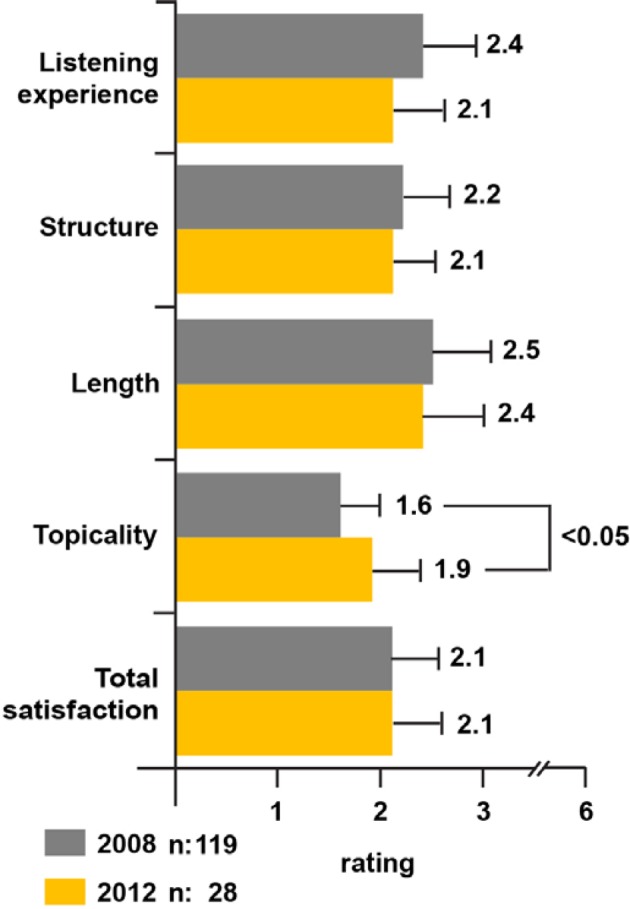
Comparing the marks of quality looking at the two times of survey, only the item topicality shows a significant difference at a p-level <0.05. The evaluation of the uses of podcasts in 2012 showed that 57% of those questioned use the podcasts to prepare for the practical course. At least 27% use them for a general understanding of biochemical contents. With just 7%, usage for recapitulating the content of the practical course was a rather minor motivation (see Table 3 (Tab. 3)). The use of podcasts for preparation of the course, the following written examination, and the understanding of lesson contents was evaluated similarly by the students (see Table 4 (Tab. 4)).
Table 4. What was the podcast useful for? (Survey 2012; rating in German school grades: 1 (very good) to 6 (insufficient)).
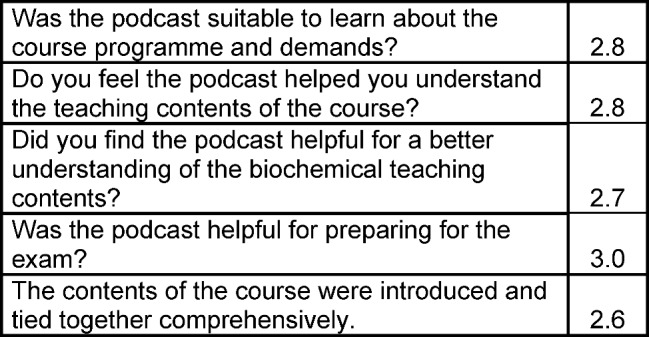
Discussion and Conclusion
Involving students, podcasts in the shape of the radio documentary can be produced to support classroom teaching with little expenses in terms of costs and time for the faculty. They are very popular with part of the students, which can be attributed to the emotional impact of the spoken word, but as well to the medium’s being free from restrictions to time and place. Even after a couple of years, the quality of the podcasts is still evaluated very positively. Nonetheless, the number of listeners strongly declined after four years, probably due to lack of awareness amongst the students. Upon their introduction, the podcasts had been promoted in lectures and seminars as well as via messages on the e-learning platform. This advertisement was missing in the following years, but seems to be necessary in order to advise interested students of the offer. In case of changes in the curriculum, podcasts can, thanks to the modular structure, easily be updated by just replacing outdated text blocks of individual speakers with new ones. Beside practical courses in biochemistry, many other topics are imaginable, such as other courses, portraits of individual teachers (http://www.podcampus.de/channels/67), or interdisciplinary aspects of the faculty (http://www.podcampus.de/channels/60; http://www.podcampus.de/channels/91). In addition to their usage in blended learning, the podcasts are surprisingly often downloaded by the interested public, despite their specialised contents. In this way, they contribute to the positive visibility of biochemistry as a subject and of the medical faculty in Hamburg, as is illustrated by the very good evaluations on Podcampus and the mentioning by other universities [6], [7].
Acknowledgement
We would like to thank all involved teachers, technical assistants, clinicians, and students for their support. At the beginning of the project, Norvin Kubik and Annemarie Seidel have especially contributed a lot to its success. In addition, we would like to thank Anette Stöber and Patrick Peters of the Multimedia Kontor Hamburg for their technical support in the early years. The project was supported by the “Förderfonds Lehre” of the UKE.
Competing interests
The authors declare that they have no competing interests.
References
- 1.Kohler N, van den Bussche H. Je schwieriger desto Beliebter. Nutzen, didaktische Qualität und Schwierigkeitsgrad des vorklinischen Lehrangebots aus der Sicht von Hamburger Medizinstudenten. Ann Anat. 2004;186(3):283–288. doi: 10.1016/S0940-9602(04)80018-9. Available from: http://dx.doi.org/10.1016/S0940-9602(04)80018-9. [DOI] [PubMed] [Google Scholar]
- 2.Bloom-Schinnerl M. Der gebaute Beitrag: Ein Leitfaden für Radiojournalisten. 1st. ed. Konstanz: UVK Verlagsges.; 2002. [Google Scholar]
- 3.McLeish R. Radio Production. 5th. ed. Oxford: Focal Press, UK; [Google Scholar]
- 4.Dittler U, Krameritsch J, Nistor N, Schwarz C, Thillosen A. E-Learning: Eine Zwischenbilanz: Kritischer Rückblick als Basis eines Aufbruchs. 1st. ed. Münster: Waxmann Verlag; 2009. [Google Scholar]
- 5.Brosius F. SPSS 19. 1st. ed. Heidelberg u.a.: mitp-Verlag; 2011. [Google Scholar]
- 6.Matthé F, Kitschke D, Schumann M, Markert D. eTEACHING-Kompass: Anregungen für online-unterstützte Lehre. 2010:Arbeitsgem. eLEARNiNG. [Google Scholar]
- 7.Reinhardt A, Korner T. E-Learning-Podcast der ETH Zürich: Studentische Podcasts zur Praktikumsvorbereitung. Zürich: ETH Zürich; 2007. [Google Scholar]


